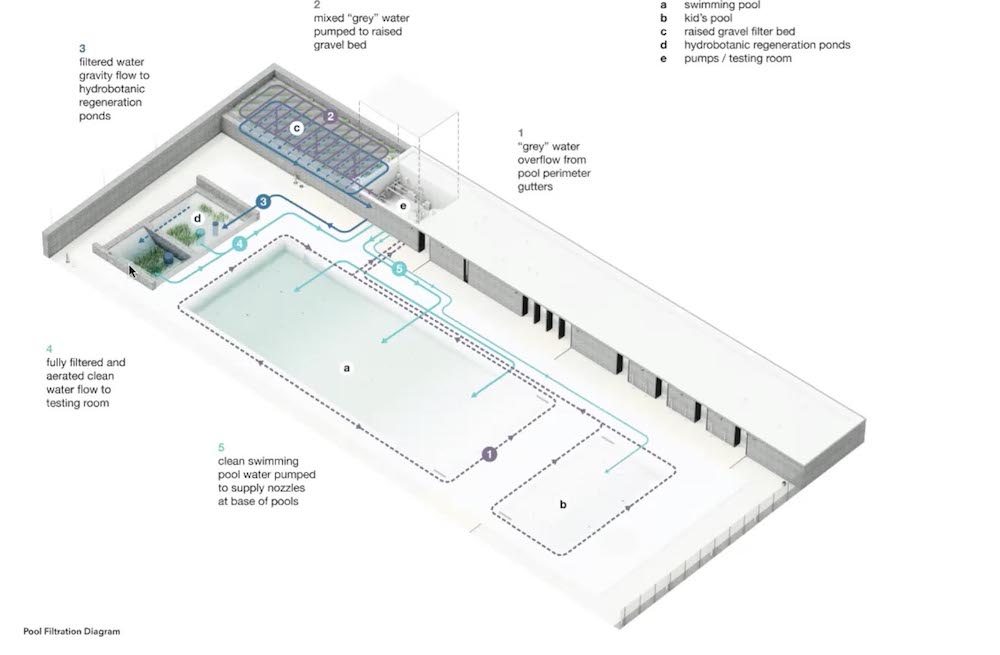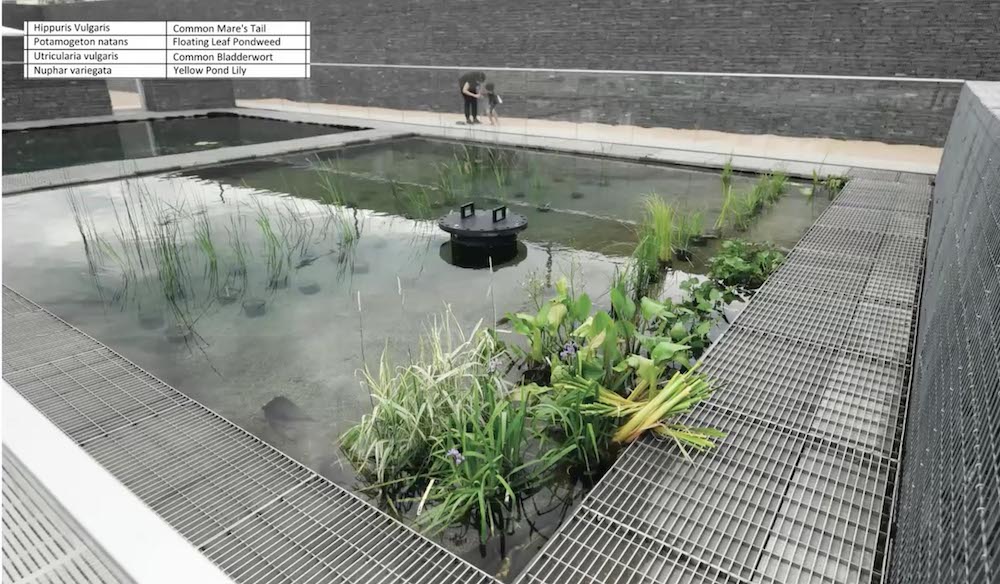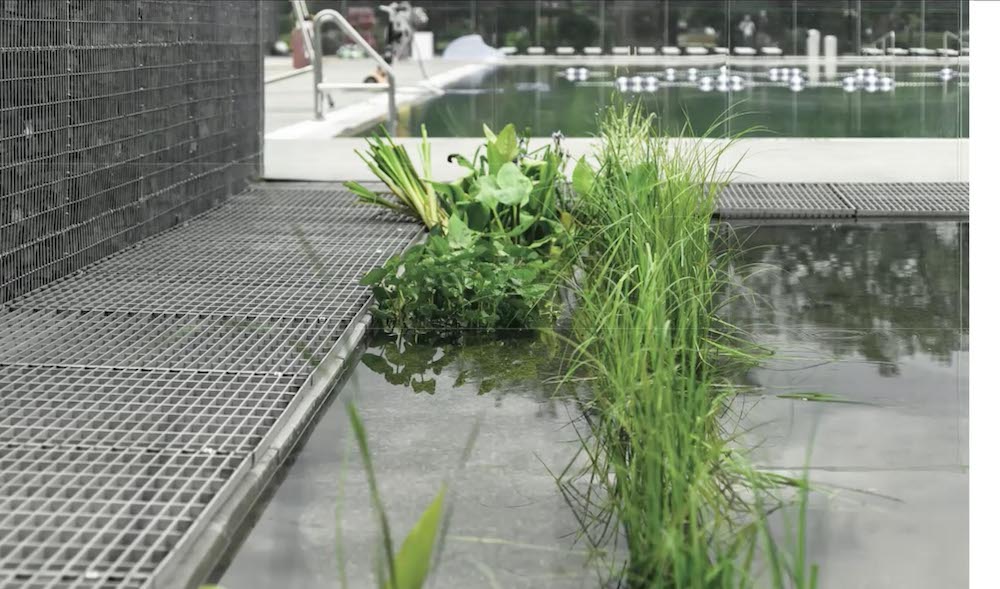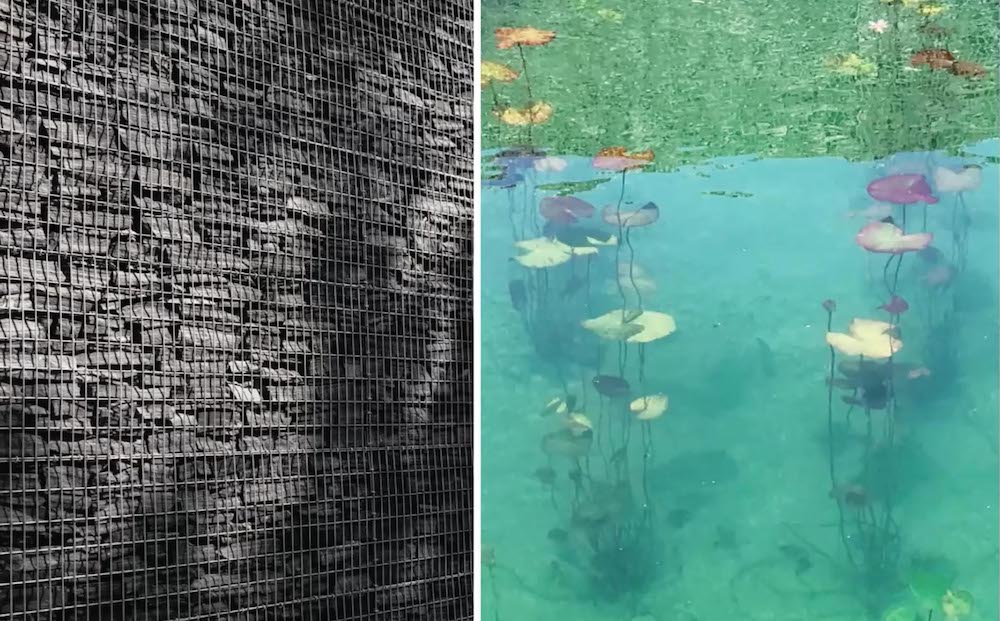Design by Detail: Plant-based bathing
Text by Victoria Taylor, OALA
“My pond drains to the brook, to the creek, to a great and needful lake. The water net connects us all.”
— Robin Wall Kimmerer, Braiding Sweetgrass.
Alive, growing and changing, plants are the protagonists in the story of the outdoor natural public swimming pool, where contemporary design weaves together biology and aesthetics, and the role landscape architects play as land-based stewards. A plant-driven strategy in three dimensions, the design and maintenance of natural swimming pools (NSP) is the same as for our own gardens; we observe and become intimate with knowing the plants and their needs over time. Rather than pouring in a chemical soup from a bucket to kill life, removing ourselves from any obligation of care, we learn the language of clean water plants to create living, public swimming environments
that are beautiful and safe.

Public interest in chemical-free, plant-filtered bathing grows as our concern grows for chemical pool treatment methods and the risks associated with exposure to the disinfection by-products (DPBs) of pool chemicals. According to Canadian design firm HCMA’s 2016 report on NSPs, swimmers can inhale pool DPBs that have vaporized above the water’s surface. “While safety measures have been established to ensure chemical concentrations remain within safe limits, there remains a lack of investigation into the full extent of these risks on human health despite the suspected carcinogenic properties.”
“Landscape—like an animal or vegetal body—is always changing. So to think about a present, fixed ‘place’ is quite a strange way to translate our position on the earth.”
— Catherine Mosbach, French Landscape Architect

In The Architecture of Bathing: Body, Landscape, Art, author, artist, and architect Christie Pearson takes us poolside to consider the spatial typologies and ecologies of bathing—the waterfall, the hamman, the spa, the pool, the pond, the sea, the spring, the banya, the jjimjilbang, the sento, and the sweat lodge. “As we look closely at these communal constructions,” Pearson writes, “their inextricability from landscape forms, bodily practices and cultural production emerges[…] Bathing environments emphasize tactility and body awareness, literally bringing us closer to materials and bodies than we are in other spaces. The phenomenology of bathing opens all of our senses.” In the chapter on Ponds: Reflection and Depth, Pearson suggests these communal spaces are “a different kind of sensual and cerebral experience” that can “simplify the complexity of how we might live intimately in our bodies, community and relationships with other humans and nonhumans.”
Continuing to design chlorinated public pools as dead, sterile environments is counterintuitive to the regenerative path we are on as land-based practitioners. With over 20,000 public/private natural pools in Europe and Mexico, over 100 public NSPs in Germany, several in the United States, and a growing number of designers and contractors focusing exclusively on this work, there are many precedents to study. Canada’s first public, chemical-free swimming pool opened in 2018 in Edmonton’s Borden Park. In 2008, when the park’s 1950s-era pool was designated for demolition, the City turned to the public for their input. An NSP was the people’s choice and, after a risk assessment phase to ensure the system would work in USDA Zone 4, the tender was issued and the contract awarded to Toronto-based gh3*. gh3*’s multi award-winning design is a beauty of precision and porosity. The dry stacked gabion walls and transparent glass guardrails conceptually connect the technical filtering of the pool water through plants, sand, and gravel. The curation of the entire project over time hinges on the performance of the plants growing in the pool’s three constructed filtration gardens. “If there is not a person watching, caring for, and tending to the plants in the construction wetlands, the whole system fails,” says Cyndi Schlosser, Borden Park facility manager. Schlosser describes her experience managing this successful public project as a journey of learning to care for plants. Specific plants are chosen to oxygenate the water and also process the swimmer’s own “biodomes” of natural bacteria, taking in the contaminants from our bodies as food.

gh3* worked closely with German-based Polyplan for the Borden Park pool. Elise Shelley, director of landscape at gh3* and a speaker on the OALA’s online panel The Art + Culture of Bathing: A Landscape Perspective sponsored by VTLA and Park Street Solutions for World Bathing Day 2021, describes how Borden Park’s pool “involves a balanced ecosystem where plant materials, microorganisms and nutrients all come together within this gravel and sand filtering process to create living water. The granular and porous filtration is achieved by means of a biological/mechanical system or the constructed wetland and gravel filter, and in situ with zooplankton.” With no local or national bylaws to guide the design specifications, and with such strict guidelines for public pools, Shelley adds “a creative approach was required in order to realize the vision. gh3* ended up classifying this project as recreational waters. The building permit lists the project as a ‘constructed beach’ with variances, and the variances are the pools.”
“Designing for life in the aquatic commons reminds us that public space design is not just about land.”
— Christie Pearson, World Bathing Day 2021, OALA speakers event.

NSP expands the opportunities to design with plants. The looped process is phased over time with pumps and gravity. Water pumps in the technical building convey collected water from the pool to the phase-one 2.5 metre-deep Neptune filter, a raised garden of sand and plants where water is distributed via nozzles onto the surface planted with Iris vesicolor (Blue Water Iris), Caltha palustris (Marsh Marigold), Alisma triviale (Water Plantain), and Carex lacustris (Lake Sedge). Slowly percolating down from the Neptune filter, the water treatment continues to the lower gardens: the hydrobotanical and submersive filters. The plants in these gardens are specified for depth and function. The hydrobotanical filter includes Eichornia crassipes (Water Hyacinth), Pistia stratiodes (Water Lettuce), Lemna minor (Common Duckweed), Nymphaea var (Water Lily), and Stuckenia pectinata (Pondweed). The submersive filter includes Caltha palustris (Marsh Marigold), Scirpus acutus (Hardstem Bulrush), Phalaris arundinacea variegata (Variegated Reed Grass), Typha latiolia (Common Cattail ), and Polygonum amphibium (Water Smartweed).
While data is still being collected and assessed for Borden Park, the public health and cost benefits are becoming clear. When we plunge into the living water, we become part of a hydrological cycle of filtering and feeding. We consider our public bathing choices and the downstream effects. We relearn and expand our knowledge and skills around public pool design: slowing down to the pace of landscape to push our public agencies to consider more progressive options. Now is the time to pose the challenge to Waterfront Toronto in particular, as this public agency leads the design of two new outdoor public swimming pools for the Parliament Slip precinct, located in the city’s east end. With Edmonton’s example, this project can expand Waterfront Toronto’s Marine Use Strategy guidelines, realizing their goal for healthy outdoor recreation at the water’s edge and setting a higher standard for the way the public engages with water recreationally.
Watch the OALA’s The Art + Culture of Bathing: A Landscape Perspective forum.
Borden Park NSP stats:
Architects and Landscape Architects: gh3*
Budget: $14.4 Million
Consultants: Polyplan (pool engineering), Morrison Hershfield (structural, mechanical, electrical, LEED, civil), Associated Engineering (gabions), BTY (cost)
Contractor: EllisDon
Pool Owner/Operator: City of Edmonton
Borden Park Awards:
2021 Civic Trust International Award
2021 International Architecture Award
2020 Governor General’s Medal in Architecture
2020 OAA Design Excellence Award
2020 Fast Company World’s Most Innovative Companies In Architecture
2019 RAIC Award of Excellence for Innovation in Architecture
2019 City of Edmonton Urban Design Award of Excellence
2014 Canadian Architect Award of Excellence
Source: www.gh3.ca
BIO/ Victoria Taylor, OALA, is principal of VTLA Studio and co founder/ co curator of ====\\DeRAIL Platform for Art + Architecture. vtla.ca
